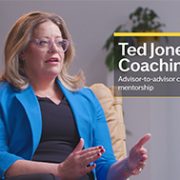The freedom to build your practice your way, backed by our support. New digital tools to help you grow — and strengthen — client relationships. A purpose-driven culture built on client-first values. Training and opportunities to take on leadership roles. The ability to make a positive impact on your clients and community, with the flexibility to stay true to your values and pursue your own life goals. These are just some of the ways we can help you take your practice to the next level.
Insider stories series:
Compensation
This episode features Edward Jones Financial Advisors Jill Hitchcock and Bryn Henderson discussing Edward Jones’ transparent and multi-layered compensation structure.
Read the transcript or view the audio described video.
Share this post:
The Edward Jones insider stories series features practicing Edward Jones’ financial advisors having honest conversations about the topics experienced financial advisors care about most. Like meeting with a trusted friend in the industry, each episode in the series provides genuine insights into what it’s really like to work as an Edward Jones financial advisor. Whether you’re early in your career, established in your practice or have built a book of high-net-worth clients, this series will provide you an inside view of how Edward Jones’ partnership model, culture of caring, technology, resources and transparent compensation structure can help you build your business.
From branch profitability bonuses and industry-leading benefits to the opportunity to earn trips of a lifetime through our travel award program, Edward Jones takes care of you, your family and your future.
“The total compensation is one of those things that is a little bit more complex than most people expect. There’s a lot of different pieces — and they just stack on top of each other.”
Bryn Henderson, Financial Advisor
On Compensation
Episode highlights include:
- Compensation: Performance-driven with no earnings caps
- Benefits: Support the physical and emotional health of you and your family
- Travel Award Program: Over 60% of financial advisors qualified to attend
- Culture of Caring: For employees and clients
- Onboarding Specialists: For advisors moving to Edward Jones
If you’re already licensed as a financial advisor, learn how we’re built to take your practice to the next level.
Related Posts
Insider stories series:
Growth + opportunities
This episode features Edward Jones Financial Advisors Michael Fessler and Kristy Stadnyk discussing the opportunity for growth, partnership culture and support that attracted them to Edward Jones — and makes them stay.
Read the Transcript or View the Audio Described Video.
Share this post:
The Edward Jones insider stories series features practicing Edward Jones’ financial advisors having honest conversations about the topics experienced financial advisors care about most. Like meeting with a trusted friend in the industry, each episode in the series provides genuine insights into what it’s really like to work as an Edward Jones financial advisor. Whether you’re early in your career, established in your practice or have built a book of high-net-worth clients, this series will provide you an inside view of how Edward Jones’ partnership model, culture of caring, technology, resources and transparent compensation structure can help you build your business.
“My business has really taken off since I’ve come to Edward Jones.”
Michael Fessler, Financial Advisor
On Growth + Opportunities
Episode highlights include:
- Limited and/or general partners: With a capacity to share earnings
- Resources for growth: Home office, business coaches, mentors, peers
- Your opinion matters: A partnership structure with the spirit of collaboration
- Ted Jones coaching: Advisor-to advisor coaching and mentorship
- The partnership difference: It’s a culture of caring instead of competition
If you’re already licensed as a financial advisor, learn how we’re built to take your practice to the next level.
Related Posts
Ready to learn more about moving your practice to Edward Jones?
Insider stories series:
Culture
This episode features Edward Jones financial advisors Jill Hitchcock, Michael Fessler, Susie Atondo, Nicholas Pennino, Kristy Stadnyk and Bryn Henderson talking about what it is that makes the Edward Jones culture so different.
Read the Transcript or View the Audio Described Video.
Share this post:
The Edward Jones insider stories series features practicing Edward Jones’ financial advisors having honest conversations about the topics experienced financial advisors care about most. Like meeting with a trusted friend in the industry, each episode in the series provides genuine insights into what it’s really like to work as an Edward Jones financial advisor. Whether you’re early in your career, established in your practice or have built a book of high-net-worth clients, this series will provide you an inside view of how Edward Jones’ partnership model, culture of caring, technology, resources and transparent compensation structure can help you build your business.
Our associates often say they came to Edward Jones for the opportunity, but they stay for the culture.
“The culture at Edward Jones of support, of encouragement, of helping one another build businesses — as opposed to being competitive and trying to get ahead at all costs — it’s so different than the culture in so much of the corporate world.”
Nicholas Pennino, Financial Advisor
On Culture
Episode highlights include:
- Caring & compassion: For employees and clients
- Inclusive & collaborative: Because we answer to each other
- 1:1 Connections: While serving 7 million clients
- Work/life & life/life: For a balanced, full life
- Support & encouragement: Zero competing interests
- Support from regions: And other peers
- Community outreach: That brings measurable impact
If you’re already licensed as a financial advisor, If you’re already licensed as a financial advisor, learn how we’re built to take your practice to the next level.
Related Posts
Insider stories series:
Technology + resources
This episode features Edward Jones Financial Advisors Nicholas Pennino and Alexander Kerford discussing how Edward Jones’ investment in technology — co-created with our financial advisors and tailored to their business needs — is helping us better serve the increasingly complex needs of high-net-worth clients.
Read the Transcript or View the Audio Described Video.
Share this post:
The Edward Jones insider stories series features practicing Edward Jones’ financial advisors having honest conversations about the topics experienced financial advisors care about most. Like meeting with a trusted friend in the industry, each episode in the series provides genuine insights into what it’s really like to work as an Edward Jones financial advisor. Whether you’re early in your career, established in your practice or have built a book of high-net-worth clients, this series will provide you an inside view of how Edward Jones’ partnership model, culture of caring, technology, resources and transparent compensation structure can help you build your business.
“Our capabilities to service clients that have more complex, more robust needs has really taken off.”
Alexander Kerford, Financial Advisor
On Technology + Resources
Episode highlights include:
- High-Net-Worth: We support more robust and complex clients
- Integrated Systems: Risk analysis, client relationship management, trading platform and more tools
- Mobile or Desktop: Consistent, integrated experience for clients
- $1.5 Billion: Invested in technology for financial advisors
- The Client Consultation Group: Provides additional support for high-net-worth clients
- Hands-on Training: A culture of co-creation
- Tools Tailored: To the advisor experience
If you’re already licensed as a financial advisor, learn how we’re built to take your practice to the next level.
Related Posts
Experienced Financial Advisor
Leveling up your practice with professional designations
by David Chubak
Share this post:

It’s time to act. Client demand for financial advisors will soon be at an all-time high and that means even experienced financial advisors need to advance their acumen to serve these clients and differentiate in a competitive market. With an eye on the future, here at Edward Jones we’re investing in development opportunities for our financial advisors, including supporting professional designations. Cerulli research shows more than 37% of industry advisors will retire over the next decade – a group responsible for more than 41% of total assets. It’s no surprise that I’m often asked by established financial advisors how they can attract more clients. To which I reply: Have you considered how to stand out when trying to attract clients whose financial advisors are retiring? One of the most common recommendations I provide is being proactive about pursuing personal development. Professional designations are an opportunity for financial advisors to level-up their knowledge and serve clients more deeply. These certifications can help a financial advisor become more competitive or establish a niche for their practice, but they are a significant commitment of time and resources. That’s one reason Edward Jones is supporting our financial advisors along the way. If you’re looking to be more competitive, do two things: Assess your competitive edge First, have an honest conversation with yourself about what you can offer clients. As investors think about their next financial advisor relationship, it’s important to position yourself as a credible partner-of-choice – and professional designations can help. After all, the CFP Board tells us that 90% of consumers see a financial advisor’s certifications as important, and 86% of consumers prefer an advisor who has passed a certification exam and rigorous education program. When investors can filter financial advisor options as easily as selecting a show to watch, designations can quickly communicate your qualifications and “stop the scroll.” Not only does this show potential clients you’re committed to continual improvement, but it also conveys specialty. Your professional development should always align with your practice goals. Think about where you are trying to take your business. If you’re trying to show general experience to a broad pool of prospective clients, maybe the Certified Financial Planner®, or CFP®, certification is right for you. But if you serve business owner clients, a Certified Exit Planner Advisor, or CEPA®, designation might be better to show that you focus on succession planning. An added bonus of obtaining a certification? Confidence. That’s what Durham, NC Financial Advisor Julie Kelly told me was one of the results she saw when she pursued her CFP®, “you have a seat at the table for comprehensive conversations. When you can look across a client’s whole financial life, those conversations are impactful. Also, your business becomes more referrable.” Seek support from your firm Once you have the conversation with yourself, take stock of the resources you have access to that can help you achieve a designation. Does your firm provide study support? What about financial incentives? At Edward Jones, we provide coaching resources to help our financial advisors create goals for their practice. With a clear plan, our financial advisors can determine which professional designations best serve their ideal client. Edward Jones supports 24 designations. We provide financial support for certification programs and offer coaches and mentors to help along the way. Investing in our financial advisors’ acumen will help us serve clients more completely and as a private partnership, it’s good for our business. It’s making a difference; we’re No. 1 in the industry for most CFP® professionals, with more than 4,500 associates in the U.S. field and home office as of December 31, 2024. Your clients and prospects have complex lives, and with that comes varying expectations of their financial advisors. Professional designations can help you understand the depth of client needs and advance your industry knowledge, making your more competitive in the process.
Interested in the Edward Jones financial advisor opportunity?
If you’re already licensed as a financial advisor, learn how we’re built to take your practice to the next level.
Experienced Financial Advisor
Thriving at Edward Jones, featuring Edward Jones financial advisor Troy Nelson
by David Chubak
Share this post:

Every financial advisor wants to help clients achieve their goals and build a thriving practice, but a firm’s purpose and culture can determine whether a financial advisor can succeed in these pursuits. At Edward Jones we’ve created a community and support system that is designed to help every financial advisor grow their practice and develop personally. We’re proud to provide every financial advisor with the resources we believe they need to succeed. But what does that look like in practice? I had the chance to speak with Financial Advisor Troy Nelson about our culture, his purpose and how both have helped him build an Edward Jones practice that manages $1.2 billion in assets with clients in 30 states. Keep reading to learn more about his keys to success. David: Thanks for making time to speak with me, Troy. Let’s start at the beginning. How did you become an Edward Jones financial advisor? Troy: So great speaking with you, David. Always appreciate the chance to connect with our Home Office leaders. Growing up I was really inspired by my dad, who trained financial advisors at a few different firms about complex estate planning matters. Investing was always a topic at the dinner table, and I was interested in the markets from a young age. After studying finance in college, I applied to be a financial advisor several places, but Edward Jones was my first choice. I still remember the day I got that “we regret to inform you” letter from the firm. I was so dejected, but realized they had it all wrong. They just needed to know me better. The recruiter’s phone number was on the letter, so I called her up and respectfully explained all the reasons I was going to make a difference in people’s lives. The recruiter was impressed with my perseverance, and I was welcomed into the hiring process. The rest is history. “I have learned more from the valleys than the mountain tops. To be able to communicate that in a real and practical way can help folks avoid the same mistakes and learn from my successes.” – Troy Nelson, Edward Jones Financial Advisor and Principal I started my practice with no assets in North Dakota. Today, Nelson Wealth Management is a team of ten. David: That’s an incredible story, Troy. You’ve been so successful here at Edward Jones. What are the qualities of a financial advisor who’s successful at the firm? Troy: First and foremost, to succeed at Edward Jones, you need to have a deep level of care for the clients you serve. I always say that “people don’t care how much you know until they know how much you care.” Our culture is one that puts the focus on serving others – we want to leave clients better off than when we found them. Second, every Edward Jones financial advisor should bring a growth mindset to their practice. They should always want to be a better version of themselves and be curious enough to continually learn. David: Great insights, especially about learning and development. I’m so proud of the growth resources and ongoing training we provide to every financial advisor in the firm. Experienced financial advisors, like you, are an important part of the support we provide our financial advisors. You mentor Edward Jones financial advisors and travel around the country to speak. What do you say to those financial advisors? Troy: A lot of it is telling people about my journey as a financial advisor. Sharing successes and sharing my failures – both personal and business. I hate to admit this, but I have learned more from the valleys than the mountain tops. To be able to communicate that in a real and practical way can help folks avoid the same mistakes and learn from my successes. It’s also sharing how my role had changed as a financial advisor throughout the years. I used to be a holistic financial problem solver, but now I’m also a much more of a counselor/psychologist/coach to clients. A guide for life’s ups and downs. That helps me know my clients much more deeply. David: You’re highlighting the nobility of the profession and it’s clear you are purpose-driven in your role. The firm’s purpose — to partner for positive impact, to improve the lives of our clients and colleagues, and communities – drives us all here at Edward Jones. Tell us more about how you live out our purpose in your practice. Troy: I have a personal mission statement – to use my gift of influence to help leaders grow in emotional health and vulnerability for bigger impact. It’s helped me in so many ways in life in general. When opportunities come at me, I have a filter to run opportunities through. This not only guides me as I serve clients, but when the firm asked me to become a General Partner, I knew that I could influence financial advisors in the journey to serving clients more completely and help the Home Office know what financial advisors need to be successful. As a partnership, Edward Jones’ culture is collaborative. So, I can not only be heard by our Home Office, but also dedicate time to mentoring others. David: We know that our purpose-driven culture is unique and attractive to many in the industry. If someone was considering making a switch to Edward Jones, what would you tell them? Are there certain signs a financial advisor should look for to know it’s time to make a move? Troy: It really does come down to culture. A financial advisor should ask themselves, is the culture helping or hindering my practice? Do I have the flexibility to serve clients the way I want to? What’s my vision for the future and does it align with my firm’s? The culture at Edward Jones is all about people who create it. We don’t have just a few great associates; we have a ton. That’s why the culture is unmatched in the industry. Don’t underestimate the value of our partnership either. We’re the last standing partnership in the industry and that means we collectively share in the success of the firm, which is really unique. David: One last question. What’s one thing you would tell a financial advisor who is considering joining Edward Jones? Troy: You can do everything you’re doing for clients today at Edward Jones, but also enjoy unmatched culture and you get to share in the success. When you have everything else, plus culture, it’s unmatched. **** A big thank you to Troy for sharing his experiences and insights. It’s inspiring to hear how his purpose and our culture are driving his success. If you’re seeking a more purpose-driven culture in which to build your practice, consider Edward Jones.
Interested in the Edward Jones financial advisor opportunity?
If you’re already licensed as a financial advisor, learn how we’re built to take your practice to the next level.
Experienced Financial Advisor
Looking ahead to 2025: Resolutions for experienced financial advisors
by David Chubak
Share this post:

As we head into a new year, you’ll hear a lot about resolutions and how they can change your life, whether they are to improve your habits or how you run your practice. After reflecting on 2024, my resolution is to be a better coach and teacher. During my branch immersion experience last summer, I learned from so many individuals who took the time to invest in me and help me grow. It’s encouraged me to double down on my focus to coach team members and our next generation of talent. For experienced financial advisors, the new year can be a time to think about goals and the ways you serve your clients. So, what should financial advisors expect in the coming year and how can you resolve to best support your clients? I don’t have a crystal ball, but I can tell you this — client concerns in 2024 have not gone away and 2025 is sure to be bring change. To continue your success in the new year, you need to understand your clients’ challenges, stay informed and practice deep empathy. Understand that inflation is still a client concern Inflation remains a hot topic for clients across the income spectrum. Our recent poll showed that more than half of Americans said inflation was their main challenge to financial accountability this past year (55%). Roughly the same percentage told us that they anticipate inflation being the biggest challenge for staying financially accountable in 2025 (56%). As financial advisors, you are uniquely positioned to provide clients with guidance for navigating inflation and economic changes. The same study showed us that half of Americans believe a financial advisor could help them stay accountable on their financial goals for the New Year. Because we can’t control the markets, this is where financial advisors can really deliver value. You know it best — a relationship with a financial advisor can help clients stay accountable and well-informed as they pursue their financial goals. But to be successful in these relationships, financial advisors must connect deeply with their clients and acknowledge their very real concerns about high costs. Stay sharp on market changes We don’t know what will happen in the coming year, but change is inevitable. If financial advisors are to keep their clients on-track, you must resolve to keep yourself up to date. Are you staying on top of market changes? Or has your practice gotten so busy that it’s hard to keep up? Resolving to be in-the-know will help you be a better financial advisor and ultimately better serve your clients. At Edward Jones, our financial advisors have access to educational tools to help them keep a finger on the pulse of relevant topics and the latest market changes. Resources like our strategist one-pagers and market weekly wrap reports help them stay on top of the market changes to enable them to quickly council their clients with confidence. Practice empathy It can be easy to focus your resolutions on numbers, but you can’t forget the human side of your practice. The relationships you have with your clients should give you professional purpose and those relationships are also the foundation of your success. Making time to listen to your clients with empathy is how to you can build successful long-term relationships. Every financial advisor should resolve to have more empathy in 2025, but you should also take a look at your practice to see if you are set-up to do this successfully. Ask yourself if you have the support you need to prioritize the needs of clients. Do you have the freedom to build a practice that is client-centered? Our ownership structure gives Edward Jones financial advisors the flexibility to choose how they build and run their practices. What’s more, dedicated support resources are available to help you free up capacity so you can put clients first. I’m excited for a fresh start in the new year and will be sure to report back on how my resolution to be a better coach comes to life. As you think about what 2025 holds for your practice, remember that listening, learning and being empathetic will positively contribute to any resolution you set.
Interested in the Edward Jones financial advisor opportunity?
If you’re already licensed as a financial advisor, learn how we’re built to take your practice to the next level.
Experienced Financial Advisor
Building your practice your way featuring Nicole Schelkopf
by David Chubak
Share this post:

Every client who walks through the door looking for financial advice has different needs, goals and approaches to their finances, and that means every interaction must be personalized. Today’s financial advisors need modern tools and resources to provide this level of service and grow their practices. At Edward Jones, we equip our financial advisors to provide clients with the best experience possible – all while giving them the flexibility to grow their businesses their way. It’s critical to who we are as a firm – and don’t just take my word for it. I had the chance to catch up with Financial Advisor Nicole Schelkopf to talk about a few hot topics including the “Great Wealth Transfer” and serving the women who may inherit many of these assets. Women are set to inherit much of the $30 trillion expected to change hands between now and 2030 according to research from McKinsey, and they’ll need tailored solutions from their financial advisor. Specifically, we know they’re looking for transparency and authenticity – a recent Edward Jones survey found that 62% of financial advisors said this was a top reason as to why women clients chose to work with them. “Edward Jones is here to support you throughout your growth, providing tools and resources to serve your clients your way.” – David Chubak, principal, Head of the U.S. Business Unit and Branch Development, Edward Jones With this in mind, I set out to hear from Nicole about how she serves women clients and the resources available as she built her practice. Keep reading to learn more. David: Thanks for taking the time to speak with me. You’ve been a part of Edward Jones for almost 10 years and are a second-generation financial advisor at the firm, and it’s great to see how you’ve built such a successful practice. I want to first focus our conversation on your women clients. What are you seeing as their priorities and goals? Nicole: All my clients have unique goals and priorities, but I’m commonly seeing that my women clients are looking for a comprehensive financial strategy so that when retirement comes, or an unexpected event, they’re prepared. In other words, they’re looking for a financial cushion. David: That’s exactly what we saw in our recent survey, which found that a majority of financial advisors said that their women clients’ top financial goals are contributing to their 401(k) (63%), working toward financial independence (61%) and building personal retirement savings (56%), all pointing to women prioritizing long-term term planning and saving for the future. Of course, these goals aren’t new to us – we see them every single day working with clients. And firm tools and resources, like MoneyGuide, offer solutions for our financial advisors to support clients in helping them reach their goals. Tell us more about your approach to building your practice and what else you do to attract and retain clients. Nicole: My clients value my ability to educate and explain complex financial topics, based on what I know about my clients. I hear over and over from them, “Thank you so much, this concept finally makes sense.” That makes a world of difference when they’re considering who to go to with financial questions. David: That’s such a big piece of the job that is often overlooked. People really appreciate you meeting them where they are and taking the time to help them learn new things. We also found in our survey that the majority of financial advisors (64%) said their ability to offer personalized, tailored financial advice was one of the top reasons why women clients chose to work with them. With nearly a decade at the firm, tell me, do you have any favorite firm-wide resources or tools you lean on to support educating your clients? Nicole: Even after almost 10 years in business and a CFP designation, I still lean on Edward Jones’ education tools to help ensure I’m up to date on relevant topics based on my clients’ interests. For example, I regularly check in on the most recent estate strategies resources from the firm. A refresh can never hurt! Also notably, Edward Jones regularly shares strategist one-pagers and weekly updates on the markets, which have been a super valuable asset for me and my clients. I can digest the information and provide timely updates to my clients. Those are non-negotiable updates for me, and the first thing I do when I step into the office on Monday is read the Weekly Market Wrap. David: I make a point to read those reports too, they’re so informative. To wrap up, I want to talk a little bit about your “why.” Why you became a financial advisor and why did you choose to build your career and practice at Edward Jones? Nicole: I love having the freedom and flexibility to build my practice, my way. My dad is also a financial advisor at Edward Jones, and I grew up with him being very present in my life. For example, he prioritized attending my afternoon golf tournaments when I was in high school. I saw he could have an incredibly successful practice while having the flexibility to be there for the moments that mattered to me. Now that I’m established in my branch with my branch office administrator, I find I’m able to run my business how I see fit and how it best serves my clients. I’m really enjoying the feeling of flexibility my dad had, too. David: I love hearing about family members who are also part of Edward Jones’ legacy. Appreciate you taking the time to share your experiences at Edward Jones – financial advisors like you are what makes Edward Jones so great! A big thank you to Nicole for sharing her experience and stories, I loved hearing about how she’s been able to build a flourishing practice at Edward Jones on her terms. If you’re looking for a place to build your practice, while investing in long-term relationships with clients, Edward Jones may be a great fit.
Interested in the Edward Jones financial advisor opportunity?
If you’re already licensed as a financial advisor, learn how we’re built to take your practice to the next level.
Experienced Financial Advisor
Inside Edward Jones’ Evolving Wealth Strategy
by John Manganaro
Share this post:

What You Need to Know Some 2 1/2 years after Edward Jones announced plans to provide its 19,500 advisors with access to the MoneyGuide planning platform, more than 1.3 million client households have been served by the tool, according to Lena Haas, head of wealth management advice and solutions. That is more than twice the projected uptake at this stage, Haas recently told ThinkAdvisor, and it’s strong evidence that a healthy culture of internal “coopetition” is driving tech adoption and fostering a planning-first service mindset at the firm. Haas said she expects the vast majority of the firm’s 8 million-plus client households to eventually come to embrace the planning toolset, driven by advisor advocacy and organic market demand for more holistic financial planning services that go beyond investment management. “It’s been really special to see how our advisors are talking about the tools internally and inspiring one another to engage in this planning-first approach,” Haas said. “They are embracing a deep discovery process with their clients. What are their wants? What are their wishes? Are they protected for the future?” Other signs of an evolving planning culture, Haas said, are the fast pace of CFP designations being earned across the firm’s advisor force — along with big strategic investments and partnerships with external wealth management technology providers. This includes the recently revealed collaboration with the estate planning platform provider Vanilla via Edward Jones Ventures and new integrations with U.S. Bank, along with expanding use of the Salesforce platform in a way that delivers artificial intelligence-derived planning insights at scale. “We’re already at 5,500 branches now using Salesforce,” Haas said. “We are continuing our rapid pace of rollout throughout this year, and we’re gathering actionable insights from more than 500,000 client interactions on a weekly basis.” Teaming and Home Office Support Haas said another important area of evolution with Edward Jones is the expanding use of advisor teaming strategies, wherein multiple advisors work together to build a unified book of business within a branch office. So far, Haas said, some 2,600 advisors are working in a team-based practice, and the option has proved to be important to both advisor recruiting and advisor retention. She said the firm has gained some 360 advisors on net so far this year, and it hopes to add more even amid a highly competitive landscape. “We’re working very hard to make Edward Jones a place that makes sense for advisors to start or base their practice,” Haas said. “That includes the teaming approach, which has been available for more than two years now, as well as new home office support offerings that have been very popular.” The support offerings, according to Haas, are delivered by an on-call team of specialists with expertise across a variety of knowledge domains, including estate planning, taxation, portfolio transition management and insurance. “Access to these experts allows our financial advisors to help their wealth clients in a deeper way — without having to learn every single aspect do everything themselves,” Haas said. “For example, advisors can get support when it comes to things like planning a multi-year tax transition for a client with a complicated portfolio.” The partnership with Vanilla is another way that Edward Jones is helping advisors do more for their clients more efficiently, Haas added, especially with many clients entering retirement and seeking to get their legacy planning in order. Winning Next-Gen Clients Asked what she sees as potential challenges for Edward Jones and the advisory industry at large, Haas said that firms need to take care to replace retiring advisors with younger and more diverse faces. By the same token, Haas said, firms need to ensure that their advisory offerings resonate with younger generations of clients who stand to both earn and inherit significant wealth. Haas pointed to findings from a 2023 Edward Jones survey showing that the majority of Americans ages 18 to 34 view themselves as struggling or merely surviving in life — yet this group is also optimistic about the future. “With most worried about rising costs and an inability to save, this will have vast implications for the wealth management industry,” Haas said. “Our purpose calls us to identify how we might help this age group plan and reach their life goals — across health, family, purpose and finances.” Survey respondents cited a short-term mindset when it comes to finances, Haas noted, focusing on everyday expenses, budgeting and saving for large purchases over other financial matters. Only 13% have paid off college debt, only 57% have health insurance and less than a third (27%) have life insurance. To thrive, those in this life stage could benefit from financial education and professional advice, Haas said. Currently, however, only 12% go to a financial advisor to discuss their finances, while 52% speak with their parents as a trusted source of financial guidance. “Another feature about this generation is that, yes, they do go to social media and TikTok looking for information, but they also come to such sources with a healthy skepticism,” Haas said. Indeed, the survey findings suggest that only 1 in 5 reported using social media or influencers as trusted sources of financial guidance among the many other perspectives they seek. Also positive, Haas said, is that 68% view financial advisors as an important sounding board for ideas, and even though they are the digital generation, 66% of people in this age bracket prefer in person interactions with their financial advisors. “Working with a financial advisor can improve your financial knowledge and confidence and help you feel more in control,” Haas added. “Our research found that 68% don’t think they have enough income or savings for professional advice. But it’s never too early to get started. Financial advisors can remove complexity and help you focus on the most important first steps.”
Interested in the Edward Jones Financial Advisor Opportunity?
If you’re already licensed as a financial advisor, learn how we’re built to take your practice to the next level.
Get a deeper understanding about moving your practice to Edward Jones by showing your interest and a knowledgeable professional will reach out to you.
Get a deeper understanding about moving your practice to Edward Jones by showing your interest and a knowledgeable professional will reach out to you.
Experienced Financial Advisor
Leaving a Legacy: Successful Succession Planning for Financial Advisors
by David Chubak
Share this post:

As an experienced financial advisor, you know how to build a successful practice by supporting your clients through each stage of their lives, and it’s important to remember how long-term planning will apply to you and your business. Cerulli reports that 37.5% of industry financial advisors will likely retire during the next 10 years, and while the short-term priorities associated with running and growing your business might feel more urgent than planning for your future succession, preparation today can help provide a smooth transition for your clients and create an enduring legacy for your practice and preserve your reputation. At Edward Jones, succession planning for financial advisors is part of our commitment to supporting clients and colleagues alike. A Financial Advisor’s Roadmap to Retirement Deciding when it’s time to retire from your practice is not an easy decision, let alone managing the various influences you encounter in the early stages of planning. It takes time to get comfortable with your own succession plan and feel confident in your successor’s ability to maintain the level of service your clients have come to expect. At Edward Jones, we can help you implement a clear and comprehensive plan to alleviate these concerns. Our financial advisors are backed by firm support throughout their career trajectory at Edward Jones, which is why our structured framework for retirement transition plans is designed to empower financial advisors as they navigate their next chapter. Our roadmap thoughtfully lays out the six steps you’ll take through your retirement transition, from the inquiry and assessment stage through plan completion. This gives you the opportunity to assess the situation – deciding when you want to retire – and design the plan that works best for you. Just as we are there to support our financial advisors with coaching and peer support when building a practice, we are also there to provide the resources and guidance necessary for successful succession planning for financial advisors. “Whether you are considering retiring within the next decade or beyond, at Edward Jones, we can help ensure your practice and legacy continue well into the future.” – David Chubak, principal, Head of the U.S. Business Unit and Branch Development, Edward Jones Keys to Success(ion) No one knows your clients and practice like you do. One way to ensure your clients are in the right hands is through a successor selection process that matches your clients with a financial advisor best suited to their needs. This a collaborative process, meaning you will play a pivotal role in ensuring the next generation has the tools and client know-how to succeed. It is important for you to share what keeps your practice going to help ensure its future success and maintain the momentum you’ve worked hard to create. From administrative needs to client nuances, equipping your successor with the right information makes all the difference. In fact, Edward Jones’ research shows that business owner clients need support with maintaining business continuity during the transition period (57%). We also found they need comprehensive planning and ensuring adequate resources for the transition (56%). Tackling these hurdles early through constant communication helps mitigate confusion for your successor and your clients. Whether you are considering retiring within the next decade or beyond, at Edward Jones, we support succession planning for financial advisors by helping ensure your practice and legacy continue well into the future.
Interested in the Edward Jones Financial Advisor Opportunity?
If you’re already licensed as a financial advisor, learn how we’re built to take your practice to the next level.
- Contact
- Site Map
- Privacy Notice
- Beware Of Employment Scams – US
- Beware Of Employment Scams – Canada
- Family And Medical Leave Act
- Equal Employment Opportunity
- County of L.A. Fair Chance Ordinance for Employers
- Employee Polygraph Protection Act
- EdwardJones.com
- EdwardJones.ca
- Candidate Application Status
- Blog
- Cookie Preference Management
Copyright © 2025 At Edward Jones, our human-centered culture calls upon us all to treat every individual with dignity and respect while celebrating what makes us unique, which we show as an equal opportunity employer committed to inclusion and accessibility. Edward Jones does not discriminate on the basis of race, color, sex (including sexual orientation, gender identity and pregnancy), religion, national origin, age, disability, veteran status, genetic information, citizenship status or any other basis prohibited by applicable federal, state, provincial, or local law in employment decisions such as hiring, compensation, benefits, transfers, promotions, leaves, training, performance expectations, development opportunities, and corrective action. Qualified applicants with arrest and/or conviction records will be considered for employment in a manner consistent with applicable federal, state, or local law, including but not limited to the St. Louis “Ban the Box” law, the San Francisco Fair Chance Ordinance, the Los Angeles Fair Chance Initiative for Hiring and the New York City Fair Chance Act.
Should you require any ADA/Medical accommodation or accommodation in accordance with applicable accessibility and/or human rights laws at any time in the application for employment, please contact us at recruiting-accommodations@edwardjones.com.










